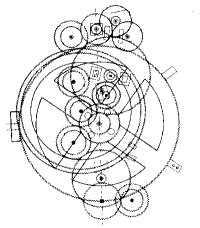
In 1900, sponge divers were retrieving relics from an ancient Greek shipwreck when archaeologist Spyridon Stais noticed a rock with a gear wheel in it. He had discovered the Antikythera mechanism, a remarkable clockwork computer that modeled the movements of heavenly objects as early as 87 B.C.
Using x-ray analysis, historians of science and technology have studied the mechanism closely and devised several working reconstructions. British orrery maker John Gleave believes the front dial tracked the sun and moon through the zodiac year against the Egyptian calendar. Others believe it modeled the motions of the sun, the moon, Mercury, Venus, Mars, Jupiter, and Saturn — every celestial body known to the ancient Greeks.
That last interpretation is significant: In the first century B.C. Cicero had written of an instrument “recently constructed by our friend Poseidonius, which at each revolution reproduces the same motions of the sun, the moon and the five planets.” It may have been used to calculate celestial positions at the times of certain events or births.
Whatever the details, the device was remarkably sophisticated for its day: Among other things, it uses a differential gear, which historians had previously thought was invented in the 16th century. Complex Greek creations like this may have passed through the Arab world and eventually informed European clockmaking. What other ancient technology has been lost?
